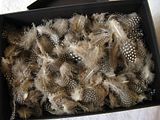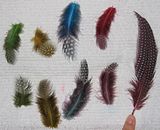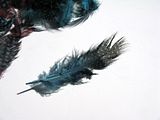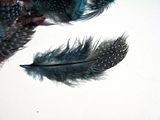
I'm doing a swap sponsored by the Ravelry Phatfiber group, and I decided to try sewing a feather fascinator, and that led to dyeing the feathers.
I've tried dyeing guineafowl feathers before, with paste food coloring in the microwave, and that worked well. I got bright colors that struck the soft afterfeathers strongly and more lightly along the vane of the feather proper. Feathers are tough for the dye stock to penetrate, both because of natural oils and because of the structure of the fiber, so that's to be expected. I also got some fantastic breaking when I used food coloring:

This time around, I went with my strong acid dye stock and a crockpot. I soaked the feathers in a strong citric acid and boiling water solution twice, letting it cool between each. I followed it up with a mild SLS solution soak for a day and then rinsed them well and left them soaking in plain water for about a week because I wasn't quite ready to dye them yet. I do think this process allowed for more dye penetration, but I think the layered process of dyeing is what resulted in the more even over all tones on the feathers.
The process was simple. I put water and vinegar in a crockpot, then added a bit of yellow dye, some wetted out feathers and let it come to a boil. I would add a new color dye and let it come to a boil between each, taking out some feathers between each dye bath after the blue one. I went through yellow, sapphire, turquoise, pink, and red. Because of the strength of the dye stocks and the proportions I used, I got mostly a teal and a reddish purple, but I'm still pretty pleased. I neglected to weigh the feathers before soaking, and it's really rather difficult to judge how much dye they'll absorb given how tough the surface is to penetrate. Up close, there's quite a bit more variation in the feathers than is initially apparent.



I think I can make something nice out of these, perhaps livened up by some of the brighter ones from the last time I did this.
Feathers always look rather a mess after they've been dyed. There's nothing more pathetic than wet feathers. Smoothing them out in one's fingers once they're dry usually brings them back, however.


ETA: The fascinator - I think doing anything else to it would be excessive. It's designed to pin to a ribbon or headband, etc, and can be worn in the hair, on the wrist or neck, or as a boutonniere.





3 comments:
When did you guys get rid of the guineafowl?
Some were killed by raccoons and other predators while ranging. Some just sort of wandered away over the years because there was a big feral flock less than a mile down the road. We gave the last four away to a farmer in the area because he had a bunch and ours were getting lonely. We haven't had guineafowl in quite a few years.
Gorgeous feathers and fascinator!
Post a Comment